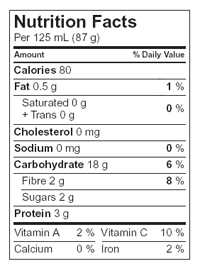How do I count carbs? And why?
Carbohydrates are one of the 3 main energy sources in food along with protein and fat. They account for most of the increase in blood sugars after meals or snacks.
Counting carbs:
- helps you determine the insulin dose you need to cover the amount of carbohydrate you are eating
- allows flexibility in everyday meal and food choices
This in turn:
- helps minimize high and low sugars (fluctuations)
- helps you reach your blood glucose goals
- ultimately prevents/lowers your risk of complications due to high blood sugars (elevated A1c- 3 month average blood sugar)
Carbohydrate counting is the only way to know how much insulin to take with a meal or snack with any degree of accuracy.
Which foods have carbohydrates?
- starchy foods
- bread, cereal, crackers, cookies
- potatoes, corn, rice, pasta, barley, kasha, couscous
- dried or canned beans, peas, lentils
- fruits and some vegetables
- all fruits
- root vegetables- tomatoes, corn, peas, carrots, turnips, squash, parsnips
- dairy
- milk, yogurt
- cottage cheese (made up of protein + carbohydrate)
- sugar and sugar-sweetened foods
- nuts, seeds
Once you know what you want to eat (meal/snack):
1. Identify which foods contain carbohydrate and how much you plan to eat (serving size)
-
it is important to either measure or weigh your food to get an accurate serving size.
-
this in turn will help you ‘train your eye’ to accurately estimate the portions of food.
-
there are new scales that can be purchased that will not only weigh your food but also give you the carb value (contact your dietitian for more details).
2. Use food labels or nutrition guides to determine the carbohydrate value for each food item based on the amount that you plan to eat (serving size). Refer below to the Fast Food Guides and Carbohydrate Counting Resources.
the amount that you plan to eat (serving size). Refer below to the Fast Food Guides and Carbohydrate Counting Resources.
The "Nutrition Facts" table is easy to find, easy to read and on most foods. Information in the table is based on a specific amount of food. Compare this to the amount you eat to determine your carbohydrate intake.
The table lists the amount of carbohydrate in a food. The number listed includes starch, sugars, and fibre. Since fibre does not raise blood glucose, subtract it from the total carbohydrate (e.g. 18 g carbohydrate – 3 g fibre = 15 g available carbohydrate).
The % Daily Value figure tells you how much nutrient is in the food.
3. When counting your carbs, remember to always subtract the fibre from the total amount of carb. Why?? Dietary fibre does not contribute/cause your sugars to rise yet it is included in the Total Carbohydrate amount. See below for more info.
4. Add the carbohydrate of each food item together to determine the total amount of carbohydrate to be eaten.
5. Keeping foods records is the best way to count carbohydrate.
- it saves time: you can refer to your record when eating the same meal versus having to do the calculation all over again
- food records will also help you to determine/establish your goal carbohydrate for each meal
Acknowledgements:
Mount Sinai Hospital: Tips for Good Nutrition in Pregnancy,
The Canadian Diabetes Association, Beyond the Basics Meal Planner, 2005, Health Canada, www.hc-sc.gc.ca





